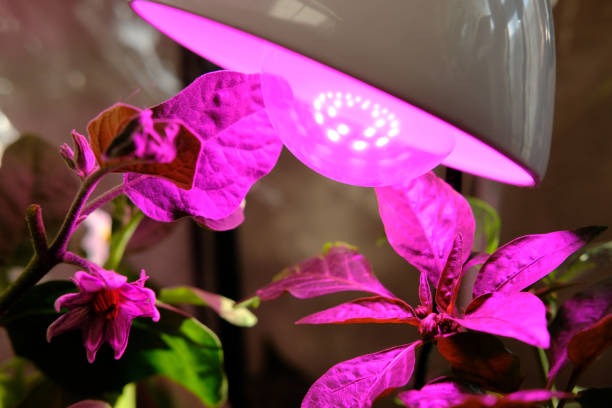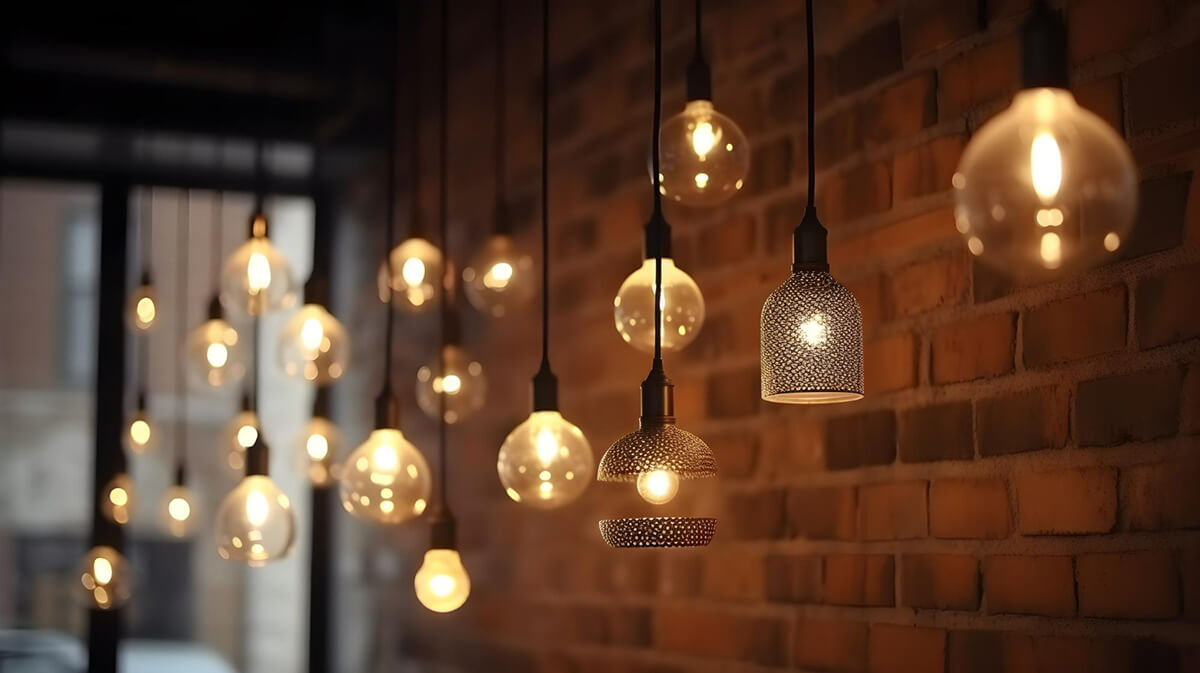Are you looking to improve your indoor plant growth? Full spectrum LED grow lights may be the solution for you. They match sunlight in wavelengths to improve plant growth and energy efficiency.
In this blog post. We’ll discuss full spectrum LED lights’ science and benefits, including longevity and durability. Full spectrum light bulbs have many benefits, but they also create heat and require an initial investment.
So you can decide, we’ll explain both sides. They’ll also discuss how spectrum control affects plant growth and which plants thrive in which spectra. After reading this article, you’ll know how to choose the right grow light spectrum.

Full Spectrum LED Grow Lights
What are Full Spectrum LED grow lights?
Full spectrum LED grow lights enhance plant growth with a variety of wavelengths. LED technology lets farmers adjust the light spectrum more precisely than conventional lights. These lights simulate sunshine, boosting photosynthesis and plant growth. LED Full spectrum grow lights support seed and flowering at lower temperatures, reducing plant damage.
Full spectrum LED grow lights, replicating natural sunlight, offer a balanced light spectrum for plant growth, promoting healthy chlorophyll production and photosynthesis.
They are energy-efficient and customizable, with factors like green light, color temperature, and CRI being essential.
What is the technology behind Full Spectrum LED lights?
Full spectrum LED lights consist of different wavelengths, stimulating various responses in plants. The blue light wavelength facilitates vegetative growth and strengthens stems and leaves.
On the other hand, the red light wavelength is crucial for flowering and fruiting stages, resulting in higher yields. A balanced spectrum of wavelengths helps plants thrive with LED grow lights.
Additionally, full spectrum light bulbs provide the necessary ultraviolet and infrared wavelengths for optimal plant development.
Spectrum control vs. fixed spectrum
Spectrum control and fixed spectrum LED grow lights offer different options for growers. Spectrum control refers to the ability to adjust the intensity and composition of light wavelengths based on plant needs and growth stages. Fixed spectrum LEDs emit a fixed ratio of light wavelengths without customization. Growers can use spectrum control for precise lighting or fixed spectrum LED lights customization setups.
Ultimately, the choice between the two depends on individual requirements.

Full Spectrum LED Grow Lights
Defining spectrum control and fixed spectrum
Spectrum control allows growers to manipulate the intensity and ratio of different light wavelengths, giving them the ability to optimize lighting conditions for various crops and growth stages. Fixed spectrum LEDs emit a fixed wavelength combination without customization.
This offers a simplified lighting solution with pre-determined wavelength ratios, making it suitable for growers who prefer a more straightforward setup.
The choice between spectrum control and fixed spectrum ultimately depends on the grower’s preference and specific plant requirements.
How to Choose the Right Spectrum for Your Needs
Your plants’ growth stage determines the LED grow light spectrum. Red light promotes flowering and fruiting, while blue light promotes vegetative growth.
Some LED grow lights offer customizable spectrums, allowing you to tailor the lighting conditions to your specific crops. Research the light requirements of your plants and consult experienced growers or horticulturists for guidance on selecting the most suitable spectrum.
Benefits of Full Spectrum LED Grow Lights
Full spectrum LED grow lights offer numerous benefits for plant growth. These lights provide a balanced light spectrum that supports overall plant health, promoting faster and healthier growth compared to traditional lighting options.
Their energy efficiency reduces electricity use and costs. LED grow lights save money due to their longer lifespan and fewer replacements. Also, the adjustable spectrum lets growers optimize lighting for maximum yield and quality.
Promotes better plant growth
Full spectrum LED grow lights play a crucial role in promoting better plant growth. These lights mimic sunlight to give plants photosynthesis wavelengths.
With a balanced light spectrum, including blue light for vegetative growth and red light for flowering, full spectrum light bulbs ensure optimal development. They also promote healthy chlorophyll production, resulting in vibrant and lush plants.
Moreover, the adjustable spectrum of LED grow lights allows growers to create customized lighting conditions tailored to specific plant needs.
Energy Efficiency
The energy efficiency of full spectrum LED grow lights is superior. These LED lights use less electricity than traditional lighting systems. LED grow lights convert electricity into light, saving energy and money.
Additionally, the reduced heat production of LED lights eliminates the need for additional cooling equipment, further saving energy.
Full-spectrum LED grow lights maximize energy savings without compromising plant growth.
Longevity and durability
LED grow lights offer exceptional longevity and durability. With a longer lifespan than traditional lighting options, they reduce replacement and maintenance costs. LED lights are shock-, vibration-, and temperature-resistant due to their solid-state construction. LED lights are less fragile without filaments or glass.
Full-spectrum LED grow lights provide long-lasting, reliable lighting for cannabis cultivation.

Full Spectrum LED Grow Lights
Drawbacks of Full Spectrum LED Grow Lights
While full-spectrum LED grow lights offer numerous benefits, it’s important to be aware of certain drawbacks.
One limitation is the fixed spectrum control, which may restrict the variety of plants that can be grown effectively.
Additionally, these lights often come with a higher initial investment compared to other lighting options. Heat emission issues can also arise, especially in enclosed spaces, impacting plant growth.
Another drawback is the lack of flexibility in adjusting light exposure for different stages of plant development.
Lastly, there may be limitations in optimizing the light spectrum to meet the specific needs of certain plants.
Initial Cost Investment
When considering full spectrum light bulbs, it’s important to acknowledge the high initial investment required. Along with the cost of purchasing the lights themselves, installation and setup expenses should be taken into account. Additional costs may arise from necessary accessories and fixtures for proper functionality.
However, it’s important to note that the long-term savings on energy costs can help offset the initial investment. Researching different brands can assist growers in finding affordable options.
Heat Emission Issues
Full spectrum LED grow lights’ heat can affect plant growth. To ensure optimal development, proper ventilation and cooling systems are necessary to regulate temperature. Some models may require additional heat dissipation mechanisms to prevent heat stress and reduce the risk of reduced photosynthesis and slower plant growth. Regular monitoring of temperature is crucial to maintaining an ideal environment for your cannabis plants. Green light, color temperature, and phosphor play vital roles in maintaining the CRI of LED grow lights.
How does spectrum control impact plant growth?
Spectrum control customizes light wavelengths, which helps plants grow. Manipulating the spectrum influences physiological processes, such as chlorophyll absorption and photosynthesis rates. Optimal spectrum control promotes healthy growth and development, optimizing crop yield and quality.
The Role of Wavelengths in Plant Growth
Different wavelengths of light elicit specific plant responses. Blue light encourages vegetative growth and compactness, while red light enhances flowering and fruiting stages. Far-red light affects plant growth patterns and photoperiodism. Optimizing wavelengths boosts plant productivity. Plant growth wavelengths optimize yield and quality.
READ ALSO; Why DAKASON LED Grow Lights Are A Game-Changer For Indoor Gardening
Visible and invisible light influence
Visible light plays a crucial role in photosynthesis and overall plant development. Besides visible light, other factors affect plant growth. UV and IR light stimulate protective compounds, root development, and flowering in some plants. Plant growth and results depend on understanding visible and invisible light.

Full Spectrum LED Grow Lights
How does a fixed spectrum affect plant development?
Fixed spectrum lighting can have limitations for different plant growth stages. Consistency in light exposure throughout the plant’s life cycle may be beneficial, but certain plants may have specific light requirements that can’t be met. Adapting to a fixed spectrum may require adjustments to other environmental factors. Proper research and planning are important.
Consistency in Light Exposure
Consistency in light exposure is crucial for optimal plant growth. Fixed spectrum lighting provides a stable and consistent light environment throughout the plant’s growth cycle, promoting uniform growth patterns. This eliminates the need for frequent adjustments and allows plants to acclimate to the fixed spectrum, resulting in predictable growth.
However, it’s important to assess the specific light requirements of each plant species to ensure the best results.
Green light, color temperature, and phosphor influence the consistency of light exposure. Cannabis growers must consider the specific light requirements of cannabis plants to achieve desired results.
The CRI (color rendering index) of LED grow lights impacts the consistency of light exposure.
Limitations in the variety of plant growth
While full spectrum LED grow lights offer many benefits for plant growth, they do have some limitations in terms of variety. Fixed spectrum lighting may not cater to the specific needs of all plant species, as some plants require specific light wavelengths for optimal growth.
The limited flexibility in adjusting the light spectrum may restrict the variety of crops that can be grown using these lights. But growers can overcome these limitations and increase plant variety by studying light needs and using other lighting.
READ ALSO: How To Hang A Grow Light: 5 Simple Steps For Indoor Gardeners
What is the Ideal Grow Light Spectrum for Various Plants
Different plant species have varying light requirements for optimal growth. Understanding specific light needs helps choose the appropriate growing light spectrum. Blue light helps leafy greens grow vegetatively, while red and far-red light help them flower and fruit.
Customizable spectrum control allows for tailoring grow lights to match individual plant requirements. These factors can help cannabis growers optimize their grow light setup for healthier, more productive plants.
Best Spectrum for Vegetable Plants
LED grow lights with a full spectrum are optimal for vegetable plants as they provide the necessary wavelengths for photosynthesis. The blue and red light wavelengths in a full spectrum LED promote healthy growth in vegetables.
Full-spectrum LED grow lights aid plant growth by mimicking sunlight. Vegetable plants require a balanced spectrum of light to thrive, making full spectrum LED lights the ideal choice.
Optimal Spectrum for Flowering Plants
Flowering plants thrive under the illumination of full spectrum LED grow lights. These lights emit a wide range of light wavelengths necessary for the flowering and fruiting stages. The red and blue light present in a full spectrum LED promote flower development and enhance overall yields. Full-spectrum LED grow lights recreate sunlight to boost flowering. For flowering plants to reach their maximum growth and blooming potential, a comprehensive light spectrum is essential.

Full Spectrum LED Grow Lights
LED Grow Light Spectrum Based on Types
LED grow lights are available in different spectrums to meet the diverse needs of plants. Broad-spectrum LED grow lights offer a wide range of wavelengths, supporting overall plant growth. On the other hand, specific-spectrum LED grow lights target specific wavelengths to address different plant growth stages.
It’s important to note that different plant types may require different LED grow light spectrums for optimal results. Additionally, LED grow light spectrums can be customized to meet the specific requirements of plants, providing flexibility and adaptability.
Broad-spectrum LED grow lights
Broad-spectrum LED grow lights encompass a wide range of light wavelengths, providing a balanced spectrum for overall plant growth. These versatile lights can be used throughout the entire plant growth cycle and mimic natural sunlight, promoting healthy photosynthesis.
With their ability to cater to various plant types, broad-spectrum LED grow lights are an ideal choice for cannabis growers and other indoor gardeners. These lights’ wide wavelength range optimizes plant growth and yields.
Specific-spectrum LED grow lights
Specific-spectrum LED grow lights are designed to target specific wavelengths for precise plant growth. These lights are tailored to optimize different stages of plant development, such as flowering or vegetative growth. Their intense light at essential wavelengths boosts plant growth and energy efficiency. LED grow lights with specific spectrums serve various plants. They give cannabis growers and horticulturists targeted light for optimal growth and results, making them versatile.
How to Choose the Right Grow Light Spectrum for Your Plant
When choosing a grow light spectrum for your plant, consider its specific light requirements. Research the optimal spectrum for your plant species and growth stage. Seek guidance from experts or experienced growers. Also, prioritize flexibility and adjustability to cater to different plant needs.
Are Full Spectrum LED grow lights worth the investment?
Considering the numerous benefits they offer, full spectrum LED grow lights are definitely worth the investment. They provide a complete range of necessary light wavelengths, enhancing plant growth and yield. Their versatility makes them suitable for various plant types and growth stages, outweighing their higher upfront cost with long-term benefits.
Evaluating the Trade-offs: Efficiency, Cost, and Plant Yield
When evaluating full spectrum LED grow lights, it’s important to consider the trade-offs in terms of efficiency, cost, and plant yield. Assess the energy efficiency of these lights and compare their initial cost with potential long-term savings on energy consumption.
Additionally, evaluate the potential increase in plant yield and quality that can be achieved with these lights. Factor in their durability and lifespan to determine their cost-effectiveness. Lastly, consider your specific needs and goals as a cannabis grower when weighing these trade-offs.

Full Spectrum LED Grow Lights
FAQ
Are full-spectrum LED lights good for growing plants?
Full-spectrum LED lights are excellent for plant growth. They emit a wide range of wavelengths that mimic natural sunlight, promoting healthy development and higher yields. However, they can be costly and may require additional equipment for optimal use.
Are full-spectrum grow lights the best?
Full-spectrum grow lights offer a wider range of light wavelengths for optimal plant growth. However, their cost may be higher compared to other types. The best grow light choice depends on your plants’ specific needs and environment. Consult gardening experts for personalized recommendations.
What are the best full-spectrum grow light bulbs?
Some of the top full-spectrum grow light bulbs include the Spider Farmer SF-1000, VIPARSPECTRA XS1500, and Phlizon CREE COB 3000W. Consider your specific growing needs and budget to find the best bulb for you. Look for bulbs with high PAR output and low heat emissions. Research and compare different brands and models before making a purchase.
What is the most powerful LED grow light on the market?
The PhytoMAX-2 1000 from Black Dog LED is currently the most powerful LED grow light on the market. It can cover 6 feet by 6 feet with 1050 watts. Other strong contenders include the Kind LED K5 XL1000 and the California Lightworks Solar System 1100. Remember, power and efficiency should both be considered when choosing a grow light.

Full Spectrum LED Grow Lights
What are the benefits of LED grow lights?
LED grow lights offer several benefits for indoor gardening. These energy-efficient devices are safer and emit less heat. Their lifespan is longer than traditional grow lights. LED grow lights can also be customized with different spectrums for specific plant growth stages. Furthermore, they are more environmentally friendly as they consume less electricity.
What are broad-spectrum LED grow lights?
Broad-spectrum LED grow lights emit a wider range of wavelengths compared to traditional LED grow lights. Mimicking natural sunlight, they promote optimal plant growth and development. While they can be more expensive, these lights are ideal for indoor gardening and plants that require full-spectrum LEDs.
To summarize, full spectrum LED grow lights improve plant growth, energy efficiency, and durability. However, heat emissions and initial investment are drawbacks.
Spectrum control chooses wavelengths to help plants grow, while fixed-spectrum lights provide consistent light but limit plant variety.
The spectrum should match your plant’s needs and weigh efficiency, cost, and yield. If full spectrum LED grow lights are worth it, it depends on your gardening needs and goals.








